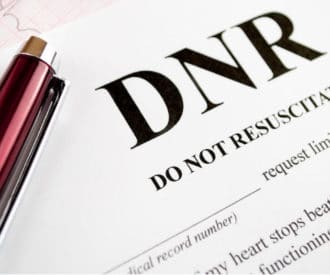
POLST vs DNR: they're two different end-of-life forms
If your older adult knows how they want to be treated during a health emergency, it’s essential to consider two important documents – a POLST and a DNR.
Both documents are available for free and ensure that your older adult’s wishes for end-of-life treatment are respected by emergency responders and hospitals.
But there are some key differences.
To help you and your older adult choose the form that works best for them, we explain what a POLST and a DNR are, differences between them, why they’re necessary, and where to get the forms.
What is a POLST?
POLST stands for Physician Orders for Life-Sustaining Treatment. It’s a one page form that specifies the end-of-life treatments that someone does or doesn’t want.
It’s legally recognized in many, but not all, U.S. states and is usually printed on bright pink paper to make it easy for emergency responders to find.
A POLST is a medical order signed by a doctor, so if your older adult stops breathing or their heart stops beating, emergency responders and hospitals must follow the POLST’s instructions.
This document is usually recommended for terminally ill or very frail seniors who have made their end-of-life wishes clear.
What is a DNR?
DNR stands for Do Not Resuscitate and is a signed medical order written by a doctor.
It tells health care providers and emergency medical personnel not to do CPR on your older adult if they stop breathing or if their heart stops beating.
The DNR is only a decision about CPR (cardiopulmonary resuscitation).
It doesn't affect any other treatments, such as pain medicine, other medicines, or nutrition.
For doctor’s orders about other end-of-life treatments, your older adult may want a POLST instead.
POLST vs DNR: the most important difference
The primary difference between and POLST and DNR is that a POLST covers a variety of end-of-life treatments. A DNR only gives instructions about CPR.
With a POLST, seniors can specify:
- If they do or don’t want CPR
- What type of life-prolonging medical interventions they’d want on top of comfort care, if any
- Under what circumstances they would want to be moved to a hospital
- If they would want a feeding tube and if so, for how long
With only a DNR, during an emergency, decisions about other interventions or treatments beyond CPR would be left to emergency responders or hospitals.
Why would seniors need a POLST or a DNR?
Without a DNR or POLST, hospitals and EMTs are required to do their best to resuscitate someone who is not breathing or doesn’t have a heartbeat.
They can’t stop these efforts without a signed medical order.
So, if your older adult doesn’t want those measures to be taken, they must have either a POLST or DNR.
How to get a POLST or DNR
After understanding your older adult’s preferences, discuss their end-of-life preferences with their doctor.
Doctors should have access to the appropriate state forms for POLST or DNR — and they must sign the form to make it official. It’s essential to use a form that’s legally recognized in your older adult’s state.
But no matter which forms are legally recognized, it’s important to discuss your older adult’s end-of-life preferences with their doctor. They can advise you on how to ensure those wishes will be carried out.
Make sure the DNR is easily accessible
A POLST or DNR can only be honored if people know it exists.
Notify doctors, nurses, caregivers, family members, and assisted living staff about your older adult’s wishes and that they have a signed POLST or DNR.
Make sure doctors, hospitals, and assisted living communities have the form on file and/or post it prominently in your senior’s room.
Print copies on neon colored paper for your hospital essentials kit and for family members.
At home, make sure the form is posted prominently near your older adult’s bed or on the refrigerator – EMTs are likely to look there.
Recommended for you:
- Honor End-of-Life Wishes With a POLST Form
- The Reality of CPR for Seniors: Get the Facts
- Simple End-of-Life Planning: The Five Wishes Living Will
By DailyCaring Editorial Team
Image: Tracee Dunblazier
[optin-monster slug=”yxbytm35zhsdfopnw7qk”][optin-monster slug=”jvhyplxmb4umsjazxecn”]
About the Author

Connie Chow
Connie was a hands-on caregiver for her grandmother for 20 years. (Grandma made it to 101 years old!) She knows how challenging, overwhelming, and all-consuming caring for an older adult can be. She also knows how important support is — especially in the form of practical solutions, valuable resources, and self-care tips.





For a loved one with end stage Dementia, on Hospice, the only reasonable choice is a DNR plus a DNI. The last thing I want for my husband is resuscitation with chest compressions that break ribs nor do I want him intubated. Fortunately, the DNR is on file and Staff knows to call Hospice, and me when he is beginning the process of dying.
It’s wonderful that you’ve thought ahead about what’s best for your husband and put the necessary paperwork and process in place
Can a Dr. tell the patient they do not want them to have DNR even though that’s the patients wish?
A person’s wishes for end-of-life are their own decision to make. The doctor makes recommendations, but the patient makes the final decision.
The information you have provided on POLST vs. DNR has been very beneficial to me since I am a caregiver and I have gone thru the end of life process several times but was never given any clarity on this subject. So glad it was an easy read. Thank you!
My husband has a POLST & an Advance Directive. This is an expanded version for f the POLST. We live here n CA.
It’s great that you have his end-of-life documents in place already.
I have a question: Is a POLST or DNR necessary if the person has named a Durable Power of Attorney for Health Care (a proxy decision-maker)? Or, another way to put it, would POLST (or DNR) interfere with the DPOA for health care’s responsibilities?
If someone has already decided what treatments they do or don’t want during emergency or end-of-life care, having a POLST or DNR readily available means that emergency responders or hospital staff can immediately follow those wishes.
If a POLST or DNR isn’t available, they’ll have to follow their usual procedures until the decision-maker arrives (and proves that they have power of attorney) and is able to specify what should or shouldn’t be done.
So, if the decision maker isn’t there, EMTs or hospitals will follow their own procedures, regardless of what the person’s wishes are.
Whether or not a proxy decision-maker can override a POLST or DNR is a complex question and is best answered by a legal professional. Basically, it will depend on the state law and what the person has specifically written into their Power of Attorney for Health Care.
The POLST organization has some guidance in Issue 7 (starts on page 16) in their legislative guide (dated 2014) — https://polst.org/wp-content/uploads/2017/02/2014.02.20-POLST-Legislative-Guide-FINAL.pdf